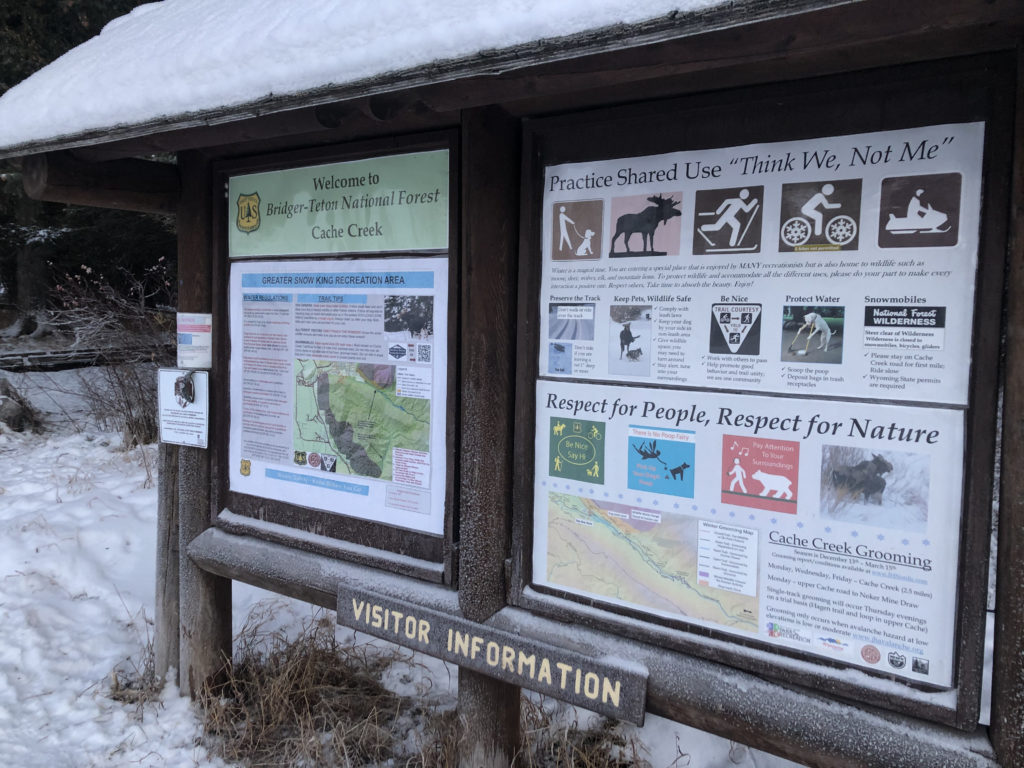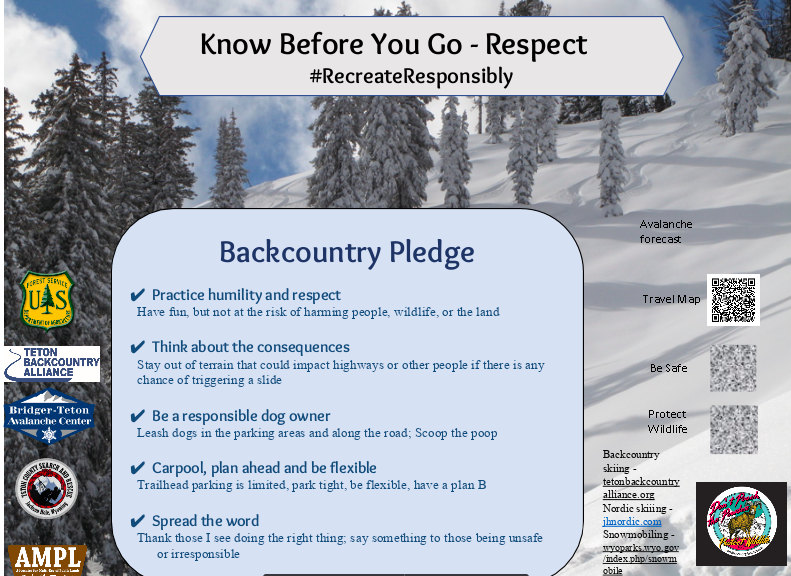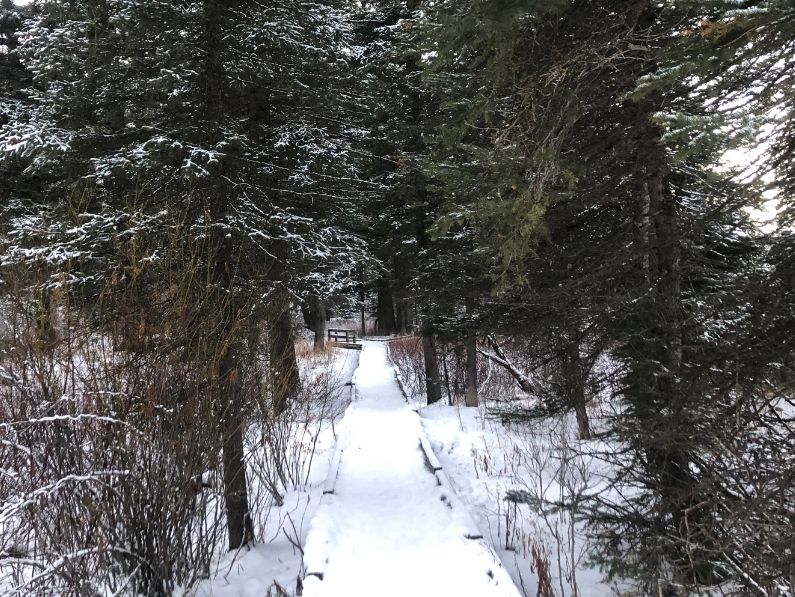The public lands surrounding Jackson Hole saw massive visitation numbers this summer and fall. Grand Teton National Park and Yellowstone National Park shattered previous records for monthly usage in October and November. And the Bridger-Teton National Forest reportedly saw a 30 percent increase this summer. Now, Bridger-Teton officials are preparing for an expected explosion of turnout this winter.
At the Cache Creek trailhead on Sunday evening, the parking lot is nearly empty. Aside from the occasional fat-tire biker, cross country skier, or dog walker meandering by, it’s a scene straight out of a Robert Frost poem. Packed snow covers a wooden pathway, and distant bird and elk calls provide a relaxing soundscape. Cache Creek is partially frozen over, with moose tracks lining the bank. And if you lean in close enough, you can hear a trickle of water meandering through this small slice of Bridger-Teton National Forest.
If you were at Cache Creek earlier in the weekend, you might be surprised to hear how peaceful it was on Sunday night. Conveniently located just a few miles from the town square, this trail is one of the most popular local spots to get in a quick walk or ride outside before work or on the weekend. Because of this, the parking lot often fills up quickly on busy days. Linda Merigliano, Recreation Program Manager at Bridger-Teton National Forest, said visitors to public lands surrounding Jackson, especially at popular spots like Cache and Game Creeks, need to be prepared for unprecedented crowds this year. Maybe, they should even have a plan B in case lots are full.
“Just expect that, even though you might be coming to Wyoming, and there might not be as many people living here as where you’re coming from, it’s still a really busy place. Particularly, in the winter,” Merigliano said.
Merigliano dealt with massive usage increases this summer at Bridger-Teton. She said the growth of Jackson as a tourist destination, coupled with COVID-19, created the perfect storm for increased use of public lands.
“We did see a segment of folks that were coming here,” she said. “People had been pent up for the last eight months. And it’s a chance to kind of break free.”
And people will be breaking free this winter, too. Backcountry and cross-country ski equipment is selling out quickly at local sporting goods stores. This creates some concerns for Merigliano. Increasing public land use inevitably leads to more dangerous wildlife encounters, trash on trails, and irresponsible behavior. These trends occurred in some cases this summer:
“So it was basically a disregard for whatever rules were out there,” Merigliano said. “And that was really, really discouraging. It’s that kind of behavior that really causes problems.
And in the harsher elements of the winter, consequences can be dire for rule-breakers. That’s why Merigliano is upping her messaging about responsible land use through websites, videos, and signage. At the Cache Creek trailhead, there’s information everywhere, asking people to be alert for wildlife and to keep their dogs under control.

A sign displaying information, including maps, best practices, and warnings, at the Cache Creek Trailhead. (Will Walkey/KHOL)
“We’ve had actually quite a few incidences of moose killing dogs. And it’s just tragic,” Merigliano said. “A moose can take down a dog pretty quickly, and that’s part of the reason why these leash requirements are really important.”
Merigliano says the vast majority of people do act responsibly, but it’s those one or two bad actors that can potentially cause closures to public lands. One goal Merigliano has this year is no pet mortalities.
Another goal is no skier triggered avalanches onto Teton Pass. To help with messaging at this highly trafficked part of Bridger-Teton, she’s leaning on her nonprofit partners with particular expertise promoting safety, access, and sustainability in a backcountry setting. Gary Kofinas, chairperson of the steering committee for the Teton Backcountry Alliance, said his organization is working very closely with Bridger-Teton. He’s concerned about the expected increase of skiers on Teton Pass this year, and lamented recent articles in both the New York Times and the Wall Street Journal, which called backcountry skiing the “sport of COVID.”
“That’s not the kind of coverage we hoped for because there are enough people who know about this place,” Kofinas said. “It has become a world-class backcountry ski destination. And for those of us who live here, it’s what we do. It’s a precious resource.”
Kofinas said mistakes out in the backcountry are often due to inexperience, and that there might be a lot of unaware folks trying the sport for the first time this winter. To mitigate growing pains, Kofinas is promoting informational web pages, passing out postcards with basic safety pledges, advocating for necessary gear, and, this year, putting, actual ambassadors up at the pass.

This postcard will be handed out to backcountry skiers renting equipment at local shops. (Courtesy of Linda Merigliano)
“You know, you see a car pull in with Virginia plates and you go, ‘Hey, have you ever been here before?’ And you have a conversation with them, and you try and share some information,” he said.
Ultimately, Kofinas said he wants to make sure he’s reaching younger, newer people, and that a culture shift toward responsibility will keep people and wildlife safe. But it’s difficult to maintain that culture as equipment makes backcountry skiing easier, Jackson becomes more populated, and more people visit.
“We have a travel and tourism board, and their tagline is, ‘Keep Jackson Hole Wild.’ And, you know, there’s an interesting tension there,” Kofinas said. “It’s like the National Park Service, which has this dual mandate to preserve these unique wild ecosystems and provide for user recreational opportunities.”
To preserve and promote: that’s the existential dilemma facing Kofinas and Merigliano. But ultimately, local outdoor partners are more interested in keeping everyone safe in spite of increased use. This includes Friends of Bridger-Teton, a nonprofit that attempts to fill in funding gaps where needs persist.
Sarah Walker, Director of Friends of Bridger-Teton, fundraises for everything from snow plowing, to infrastructure, to “unsexy” projects like toilets at trailheads. She said her organization is all the more critical now because federal infrastructure budgets alone in Bridger-Teton have been cut in recent years by over 70 percent. Her funding model follows what’s happening at Grand Teton and Yellowstone.
“So, we’re way past the point of expecting our land managers to mitigate visitor impacts on their own,” Walker said. “And the national forests are shifting more toward a model relying on nonprofit partner support.”
Walker communicates with other nonprofits to find out where their needs are, and, of course, contributes to messaging. She‘s optimistic that unified messaging will lead people to start to see themselves as stewards of the wild places where they live. Eventually, that could lead them to become philanthropic contributors.
“They’re finding a ton of value in public lands, and there’s starting to just be this shift of recognizing that we can’t expect the managers to do it on their own,” Walker said. “And if we want to protect the places we play, there’s got to be a way to give back.”
Of course, Walker is also concerned about visitor safety and responsibility. But she was reminded of the joy people have for getting outside this summer, which was by and large very successful.
“And it was amazing to see people out camping with their families this summer,” she said.
“Some of them are doing it for the first time. And so I’m excited to see that continue. I’m excited that these public lands are there for folks that need to get outside and exercise and find solitude. Or find recreation and do it safely.”
There’s no question that outdoor adventures abound in Jackson. And despite an expected increase in land use, there are still times and places where you can find solitude. You may just have to look a bit harder for it.







